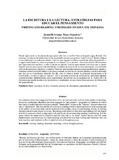Mostrar el registro sencillo del ítem
La Escritura y la Lectura: Estrategias Para Educar el Pensamiento
| dc.rights.license | http://creativecommons.org/licenses/by-nc-sa/3.0/ve/ | |
| dc.contributor.author | Jaramillo Arango, Diego Alejandro | |
| dc.date.accessioned | 2016-09-28T13:26:48Z | |
| dc.date.available | 2016-09-28T13:26:48Z | |
| dc.date.issued | 2016 | |
| dc.identifier.issn | 1690-3226 | |
| dc.identifier.uri | http://www.saber.ula.ve/handle/123456789/42388 | |
| dc.description.abstract | Desde siglos atrás se ha planteado que quien sabe leer y escribir bien es después capaz de todo. Sin embargo, la educación tradicional se ha empeñado en unos programas “anti-lectores” donde obligan a los estudiantes, en todas las edades, a leer lo que algunos eruditos consideran obras imperdibles o a seguir martillando los clásicos porque de lo contario “se es inculto”. Pero más allá del divertimento que representa leer un libro, o saber redactar un párrafo, está la capacidad de criticismo que se puede lograr con la lectura, mucho más fácil desde el análisis de un texto de ficción entretenido, o escribiendo a través de ejercicios prácticos y simples. Partir de una literatura atractiva para las diferentes edades y terminar con artículos profundos es un proceso donde los jóvenes (e incluso adultos) van descubriendo que leer no es el momento aburrido del día, sino el espacio donde la principal herramienta es la creatividad y la única regla es “querer”. En el presente artículo de reflexión se presentan algunas consideraciones fundamentales para implementar un método en la enseñanza de la redacción y la literatura que puede ayudar a los profesores y estudiantes en este maravilloso proceso de formación del pensamiento. | es_VE |
| dc.language.iso | es | es_VE |
| dc.rights | info:eu-repo/semantics/openAccess | |
| dc.subject | Escritura | es_VE |
| dc.subject | Lectura | es_VE |
| dc.subject | Literatura | es_VE |
| dc.subject | Proceso de enseñanza | es_VE |
| dc.subject | Pensamiento crítico | es_VE |
| dc.title | La Escritura y la Lectura: Estrategias Para Educar el Pensamiento | es_VE |
| dc.title.alternative | Writing and Reading: Strategies to Educate Thinking | es_VE |
| dc.type | info:eu-repo/semantics/article | |
| dc.description.abstract1 | For centuries it has been suggested that those who can read and write well are then capable of anything. However, traditional education has been engaged in “anti-reader’s” programs for students in which they have to read what some scholars consider “unmissable” works or the “classics” because otherwise one is “uncultured”. But beyond the divertimento, reading a book or knowing how to write a paragraph is the ability of criticism that can be achieved with reading a text of entertaining fiction, or writing through practical and simple exercises. Beginning with attractive literature and ending with intelligent articles is a process where young (and even adults) are discovering that reading is not boring. It is the space where the main tool is creativity and the only rule is “to want”. In this article you will some fundamental considerations for implementing a method for teaching writing and literature that can help teachers and students in this wonderful critical thought process. | es_VE |
| dc.description.colacion | 197-208 | es_VE |
| dc.description.email | diegoj@uhemisferios.edu.ec | es_VE |
| dc.description.frecuencia | Semestral | |
| dc.identifier.eissn | 2244 - 842X | |
| dc.subject.facultad | Núcleo Rafael Rangel (NURR) | es_VE |
| dc.subject.institucion | Universidad de Los Andes | es_VE |
| dc.subject.keywords | Writing | es_VE |
| dc.subject.keywords | Reading | es_VE |
| dc.subject.keywords | Literature | es_VE |
| dc.subject.keywords | Teaching | es_VE |
| dc.subject.keywords | Critical thought process | es_VE |
| dc.subject.pais | Venezuela | |
| dc.subject.publicacionelectronica | Academia | |
| dc.subject.thematiccategory | Artes y Humanidades | es_VE |
| dc.subject.tipo | Revistas | es_VE |
| dc.type.media | Texto | es_VE |


